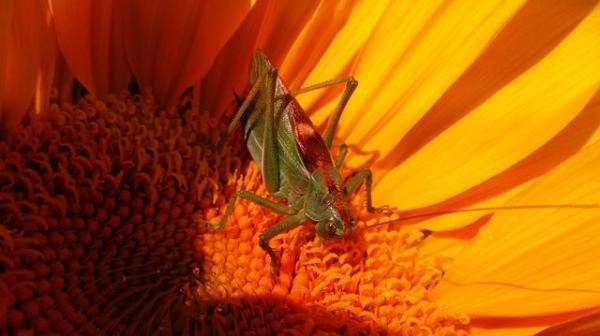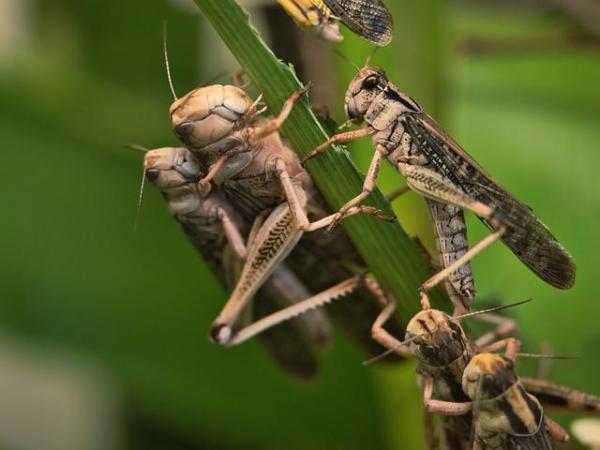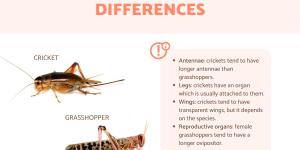Do Grasshoppers Bite?


Arthropods are the most diverse group of organisms on the planet, accounting for around 80% of all living animal species. Each individual species has adapted to their environment in certain ways. Some fly, some have long bodies and some have appendages which allow them to survive. The latter example can be seen in scorpion tails or wasp stingers. Not all arthropods are as obviously dangerous. Some can seem perfectly harmless, but can actually provide a painful bite. In this AnimalWised article, we want to know if grasshoppers fall into this category. We so do by asking do grasshoppers bite? Are they harmful to humans?
Grasshopper overview
Grasshoppers belong to the Orthoptera, an order made up of more than 26,000 grasshopper, locust and cricket species. They are found in the suborder Caelifers and the family Acrididae. The Acrididae family is further subdivided into more than 20 subfamilies. These data indicate the diversity of the group, compromising a great variety of species that share certain characteristics, but often have different sizes, colorations and other variations.
Although all of these arthropods have two pairs of wings, not all species can fly. Even in those that do, both pairs of wings are not always used for this purpose. For those grasshoppers with the power of flight, it will only be when they reach adult stage they can use this ability. A distinctive feature of grasshoppers is their legs. They are long and articulated in a way which makes them able to make great leaps, hence their given name.
Caelifera is a suborder of grasshopper which have short antenae. Ensifera are a suborder with long antennae. Regardless of length, grasshoppers use these structure to investigate their environment. Some species are capable of producing noises audible to the human ear, something we more commonly associate with crickets.
In terms of reproduction, the female grasshopper lats thousands of eggs. She usually does so in the ground or on a plant. They usually produce a secretion which protects the eggs. A process known as hemimetabola metamorphosis occurs in grasshopper. This is a gradual transformation process. Nymphs or juvenile phase individuals are very similar to adults, but smaller in size. They will then go through as series of 4 to 10 molts until they reach their full adult size.

Grasshopper habitat and diet
Grasshoppers are usually solitary insects and do not maintain social relationships with each other. However, when certain circumstances occur, some species group together, forming very large swarms. In these cases, some species change to a gregarious phase and are renamed locusts.
Grasshoppers have a global terrestrial distribution, but prefer warm or temperate regions. They develop in grasslands, crops, forests, areas of lush vegetation and gardens. Some species are found in humid areas near waterways. Others can inhabit drier lands. The species that usually live in gardens and urban areas with vegetation tend to be shy and avoid contact with people, but it is common to observe and bump into them.
Their eating habits are exclusively herbivorous. Thanks to the presence of specialized oral appendages, they can easily cut and grind the vegetation on which they feed. They consume a great diversity of plants, many of them important crops for humans. If you want to know more about the diet and feeding habits of these animals, take a look at our article on what grasshoppers eat for more information.

Are grasshoppers harmful to humans?
If we look at the eating apparatus of a grasshopper, we can see they have mandibles which are used to cut and consume vegetation. They also have sensory palps which extend from the jaws to feel and aid in eating. These specialized jaws can cut blades of grass easily and they can consume large amounts, especially in groups. Are these jaws used to bite humans?
Grasshoppers do not bite people, at least not in a way which causes any injury. If a grasshopper was trapped by a person and wanted to escape, they may try to bite them. This bite would not be strong enough to break human skin and won't cause the person any harm. At the most we may be able to feel a gentle pinch.
Although they cannot bite us, some species of grasshopper can regurgitate a dark brown liquid and others can expel hemolymph (the insect equivalent of blood) via joints in their legs. They do so as a defense mechanism against predators. When a human handles them, they can feel they are being attacked and enter defense mode. Although this can be unpleasant, it is not harsh enough to cause significant harm to humans.
When we or our children find grasshoppers in our home, it is understandable we would want to know if they are harmful to us. However, it is important to know we are more likely to do harm to them. Since grasshoppers play and important role in our ecosystems, we should leave them alone if we see one in nature.

Are grasshoppers dangerous for crops?
Although grasshoppers are not dangerous to the human organism, they are able to harm humans in an indirect way. As we stated above, when grasshoppers are in their gregarious stage, they can swarm in large numbers and become locusts. This happens due to certain environmental changes which induce a chemical transformation in grasshoppers. They produce certain pheromones which control variations in their coloration, causing them to turn a dark brown color. They also massive increase reproduction, leading to the formation of swarms.
It is these swarms of locusts which can harm humans by decimating fields of crops in just a short space of time. Normally grasshoppers do not migrate, but locusts do. They become nomadic and can fly long distances in search for food. Such large numbers require a large amount of food which can be very harmful to farmers, ruing livelihoods and much worse.
While locusts do need to be controlled, they need to be done so in an environmentally-friendly way. This means eschewing harmful chemicals for more preventive methods such as the use of naturally occurring fungi.
If you want to read similar articles to Do Grasshoppers Bite?, we recommend you visit our Facts about the animal kingdom category.
- Aguirre-Segura, A., & Barranco, P. (2015). "Class Insecta, Order Orthoptera". IDE @ -SEA Magazine, 46, 1–13.
http://sea-entomologia.org/IDE@/revista_46.pdf - Bailey, S. (1997). "Is this insect dangerous or not?" Extension Entomology. https://entomology.ca.uky.edu/content/%C2%BFes-peligroso-este-insecto-o-no
- Cucunubo, D. (2020). "Synopsis of the subfamilies Acridinae, Gomphocerinae and Oedipodinae Orthoptera: Caelifera: Acrididae for Colombia". https://ciencia.lasalle.edu.co/cgi/viewcontent.cgi?article=1092&context=biologia
- Hickman, C., Roberts, L., & Parson, A. (2000). Comprehensive principles of zoology. McGraw Hill Interamericana.








